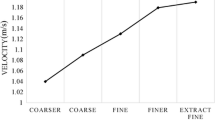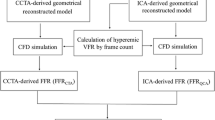Abstract
Objectives
Application of computational fluid dynamics (CFD) to three-dimensional CTCA datasets has been shown to provide accurate assessment of the hemodynamic significance of a coronary lesion. We aim to test the feasibility of calculating a novel CTCA-based virtual functional assessment index (vFAI) of coronary stenoses > 30% and ≤ 90% by using an automated in-house-developed software and to evaluate its efficacy as compared to the invasively measured fractional flow reserve (FFR).
Methods and results
In 63 patients with chest pain symptoms and intermediate (20–90%) pre-test likelihood of coronary artery disease undergoing CTCA and invasive coronary angiography with FFR measurement, vFAI calculations were performed after 3D reconstruction of the coronary vessels and flow simulations using the finite element method. A total of 74 vessels were analyzed. Mean CTCA processing time was 25(± 10) min. There was a strong correlation between vFAI and FFR, (R = 0.93, p < 0.001) and a very good agreement between the two parameters by the Bland–Altman method of analysis. The mean difference of measurements from the two methods was 0.03 (SD = 0.033), indicating a small systematic overestimation of the FFR by vFAI. Using a receiver-operating characteristic curve analysis, the optimal vFAI cutoff value for identifying an FFR threshold of ≤ 0.8 was ≤ 0.82 (95% CI 0.81 to 0.88).
Conclusions
vFAI can be effectively derived from the application of computational fluid dynamics to three-dimensional CTCA datasets. In patients with coronary stenosis severity > 30% and ≤ 90%, vFAI performs well against FFR and may efficiently distinguish between hemodynamically significant from non-significant lesions.
Key Points
-
Virtual functional assessment index (vFAI) can be effectively derived from 3D CTCA datasets.
-
In patients with coronary stenoses severity > 30% and ≤ 90%, vFAI performs well against FFR.
-
vFAI may efficiently distinguish between functionally significant from non-significant lesions.




Similar content being viewed by others
Abbreviations
- CACS:
-
Coronary artery calcium score
- CAD:
-
Coronary artery disease
- CFD:
-
Computational fluid dynamics
- CTCA:
-
Computed tomography coronary angiography
- FFR:
-
Fractional flow reserve
- ICA:
-
Invasive coronary angiography
- vFAI:
-
Virtual functional assessment index
References
De Bruyne B, Fearon WF, Pijls NH et al (2014) Fractional flow reserve–guided PCI for stable coronary artery disease. N Engl J Med 371:1208–1217
Tonino PA, De Bruyne B, Pijls NH et al (2009) Fractional flow reserve versus angiography for guiding percutaneous coronary intervention. N Engl J Med 360:213–224
Johnson NP, Tóth GG, Lai D et al (2014) Prognostic value of fractional flow reserve: linking physiologic severity to clinical outcomes. J Am Coll Cardiol 64:1641–1654
Dehmer GJ, Weaver D, Roe MT et al (2012) A contemporary view of diagnostic cardiac catheterization and percutaneous coronary intervention in the United States: a report from the CathPCI registry of the National Cardiovascular Data Registry, 2010 through June 2011. J Am Coll Cardiol 60:2017–2031
Menke J, Unterberg-Buchwald C, Staab W, Sohns JM, Seif Amir Hosseini A, Schwarz A (2013) Head-to-head comparison of prospectively triggered vs retrospectively gated coronary computed tomography angiography: meta-analysis of diagnostic accuracy, image quality, and radiation dose. Am Heart J 165(154–163):e153
Vorre MM, Abdulla J (2013) Diagnostic accuracy and radiation dose of CT coronary angiography in atrial fibrillation: systematic review and meta-analysis. Radiology 267:376–386
Koo BK, Erglis A, Doh JH et al (2011) Diagnosis of ischemia-causing coronary stenoses by noninvasive fractional flow reserve computed from coronary computed tomographic angiograms results from the prospective multicenter DISCOVER-FLOW (Diagnosis of Ischemia-Causing Stenoses Obtained Via Noninvasive Fractional Flow Reserve) study. J Am Coll Cardiol 58:1989–1997
Renker M, Schoepf UJ, Wang R et al (2014) Comparison of diagnostic value of a novel noninvasive coronary computed tomography angiography method versus standard coronary angiography for assessing fractional flow reserve. Am J Cardiol 114:1303–1308
Kruk M, Wardziak Ł, Demkow M et al (2016) Workstation-based calculation of CTA-based FFR for intermediate stenosis. JACC Cardiovasc Imaging 9:690–699
Min JK, Leipsic J, Pencina MJ et al (2012) Diagnostic accuracy of fractional flow reserve from anatomic CT angiography. JAMA 308:1237–1245
Norgaard BL, Leipsic J, Gaur S et al (2014) Diagnostic performance of noninvasive fractional flow reserve derived from coronary computed tomography angiography in suspected coronary artery disease the NXT trial (analysis of coronary blood flow using CT angiography: next steps). J Am Coll Cardiol 63:1145–1155
Morris PD, Ryan D, Morton AC et al (2013) Virtual fractional flow reserve from coronary angiography: modeling the significance of coronary lesions: results from the VIRTU-1 (VIRTUal Fractional Flow Reserve From Coronary Angiography) study. JACC Cardiovasc Interv 6:149–157
Ko BS, Cameron JD, Munnur RK et al (2016) Noninvasive CT-derived FFR based on structural and fluid analysis: a comparison with invasive FFR for detection of functionally significant stenosis. JACC Cardiovasc Imaging. https://doi.org/10.1016/j.jcmg.2016.07.005
Douglas PS, Pontone G, Hlatky MA et al (2015) Clinical outcomes of fractional flow reserve by computed tomographic angiography-guided diagnostic strategies vs. usual care in patients with suspected coronary artery disease: the prospective longitudinal trial of FFR(CT): outcome and resource impacts study. Eur Heart J 36:3359–3367
Lu MT, Ferencik M, Roberts RS et al (2017) Noninvasive FFR derived from coronary CT angiography: management and outcomes in the PROMISE trial. JACC Cardiovasc Imaging 10:1350–1358
Baumann S, Renker M, Hetjens S et al (2016) Comparison of coronary computed tomography angiography-derived vs invasive fractional flow reserve assessment: meta-analysis with subgroup evaluation of intermediate stenosis. Acad Radiol 23:1402–1411
Gaur S, Taylor CA, Jensen JM et al (2017) FFR derived from coronary CT angiography in nonculprit lesions of patients with recent STEMI. JACC Cardiovasc Imaging 10:424–433
Packard RR, Li D, Budoff MJ, Karlsberg RP (2017) Fractional flow reserve by computerized tomography and subsequent coronary revascularization. Eur Heart J Cardiovasc Imaging 18:145–152
Coenen A, Rossi A, Lubbers MM et al (2017) Integrating CT myocardial perfusion and CT-FFR in the work-up of coronary artery disease. JACC Cardiovasc Imaging. https://doi.org/10.1016/j.jcmg.2016.09.028
Yang DH, Kim YH, Roh JH et al (2017) Diagnostic performance of on-site CT-derived fractional flow reserve versus CT perfusion. Eur Heart J Cardiovasc Imaging 18:432–440
Papafaklis MI, Muramatsu T, Ishibashi Y et al (2014) Fast virtual functional assessment of intermediate coronary lesions using routine angiographic data and blood flow simulation in humans: comparison with pressure wire - fractional flow reserve. EuroIntervention 10:574–583
Athanasiou L, Rigas G, Sakellarios AI et al (2016) Three-dimensional reconstruction of coronary arteries and plaque morphology using CT angiography--comparison and registration with IVUS. BMC Med Imaging 16:9
Neglia D, Rovai D, Caselli C et al (2015) Detection of significant coronary artery disease by noninvasive anatomical and functional imaging. Circ Cardiovasc Imaging 8
Kern MJ, Lerman A, Bech JW et al (2006) Physiological assessment of coronary artery disease in the cardiac catheterization laboratory - a scientific statement from the American Heart Association Committee on Diagnostic and Interventional Cardiac Catheterization, Council on Clinical Cardiology. Circulation 114:1321–1341
Gould KL (1978) Pressure-flow characteristics of coronary stenoses in unsedated dogs at rest and during coronary vasodilation. Circ Res 43:242–253
Young DF (1979) Fluid-mechanics of arterial stenoses. J Biomech Eng 101:157–175
Brown BG, Bolson E, Frimer M, Dodge HT (1977) Quantitative coronary arteriography - estimation of dimensions, hemodynamic resistance, and atheroma mass of coronary-artery lesions using arteriogram and digital computation. Circulation 55:329–337
Kern MJ, Bach RG, Mechem CJ et al (1996) Variations in normal coronary vasodilatory reserve stratified by artery, gender, heart transplantation and coronary artery disease. J Am Coll Cardiol 28:1154–1160
Johnson NP, Kirkeeide RL, Gould KL (2013) Coronary anatomy to predict physiology: fundamental limits. Circ Cardiovasc Imaging 6:817–832
Taylor CA, Fonte TA, Min JK (2013) Computational fluid dynamics applied to cardiac computed tomography for noninvasive quantification of fractional flow reserve: scientific basis. J Am Coll Cardiol 61:2233–2241
Montalescot G, Sechtem U, Achenbach S et al (2013) 2013 ESC guidelines on the management of stable coronary artery disease. The Task Force on the management of stable coronary artery disease of the European Society of Cardiology. Eur Heart J 34:2949–3003
Patel MR, Peterson ED, Dai D et al (2010) Low diagnostic yield of elective coronary angiography. N Engl J Med 362:886–895
Liga R, Vontobel J, Rovai D et al (2016) Multicentre multi-device hybrid imaging study of coronary artery disease: results from the EValuation of INtegrated Cardiac Imaging for the Detection and Characterization of Ischaemic Heart Disease (EVINCI) hybrid imaging population. Eur Heart J Cardiovasc Imaging. https://doi.org/10.1093/ehjci/jew038
Kajander S, Joutsiniemi E, Saraste M et al (2010) Cardiac positron emission tomography/computed tomography imaging accurately detects anatomically and functionally significant coronary artery disease. Circulation 122:603–613
Morris PD, van de Vosse FN, Lawford PV, Hose DR, Gunn JP (2015) “Virtual” (computed) fractional flow reserve: current challenges and limitations. JACC Cardiovasc Interv 8:1009–1017
Funding
This work was supported in part by European Union FP7-CP-FP506 2007 (grant no. 222915) (EVINCI study) and in part by European Union’s Horizon 2020 research and innovation program under grant agreement no. 689068 (SMARTool study).
Author information
Authors and Affiliations
Corresponding author
Ethics declarations
Guarantor
The scientific guarantor of this publication is Constantinos D. Anagnostopoulos.
Conflict of interest
The authors of this manuscript declare no relationships with any companies, whose products or services may be related to the subject matter of the article.
Statistics and biometry
No complex statistical methods were necessary for this paper.
Informed consent
In the context of the EVINCI study (Neglia D et al Circ Cardiovasc Imaging. 2015 Mar;8(3). pii: e002179. doi: https://doi.org/10.1161/CIRCIMAGING.114.002179), ethical approval was provided by each participating center and all subjects gave written informed consent. For the present study investigating anonymized imaging data, informed consent was waived.
Ethical approval
Institutional Review Board approval was obtained.
Methodology
• retrospective
• diagnostic or prognostic study
• multicenter study
Additional information
All authors take responsibility for all aspects of the reliability and freedom from bias of the data presented and their discussed interpretation.
Rights and permissions
About this article
Cite this article
Siogkas, P.K., Anagnostopoulos, C.D., Liga, R. et al. Noninvasive CT-based hemodynamic assessment of coronary lesions derived from fast computational analysis: a comparison against fractional flow reserve. Eur Radiol 29, 2117–2126 (2019). https://doi.org/10.1007/s00330-018-5781-8
Received:
Revised:
Accepted:
Published:
Issue Date:
DOI: https://doi.org/10.1007/s00330-018-5781-8




